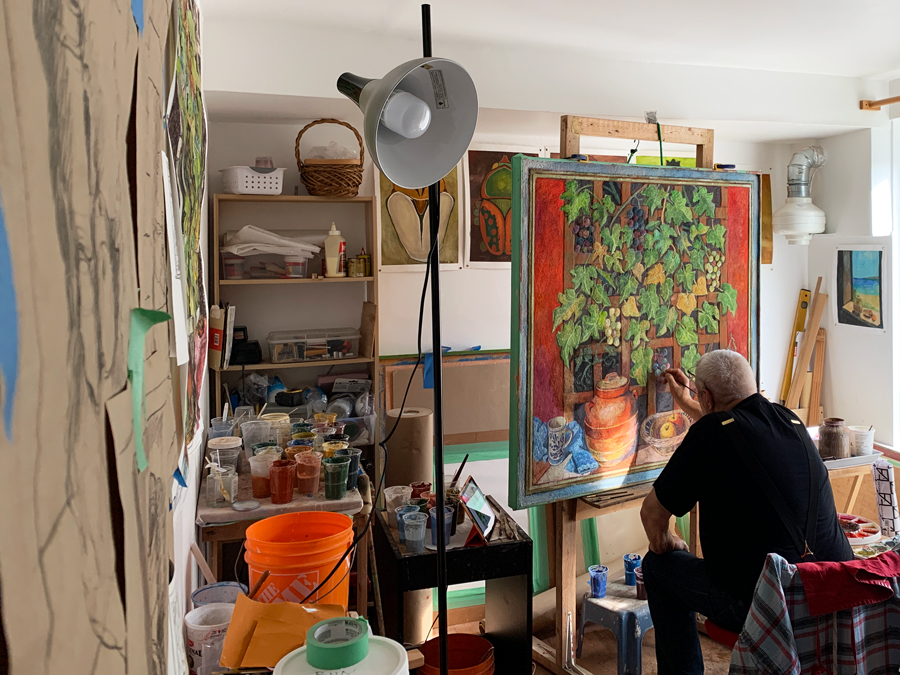
Catalino’s technique:
where painting meets sculpture
The hanging art pieces displayed on this site are all executed in Catalino's unique technique, using coloured historic mortar (also known as Roman mortar, lime mortar or traditional mortar), often incorporating genuine Sgraffito and Fresco techniques. The material used - historic mortar, made of all natural ingredients - has a unique brightness (due to the lime in its composition), true depth (it is 3-dimensional, thus enhancing the composition’s perspective), a wide range of textures, and remarkable resilience. If painting with any of the traditional painting mediums (watercolours, oil) is like playing one instrument at a time, painting with coloured mortar is like using a whole orchestra - this is how multifaceted its expression potential is.
Catalino has a refined palette, its vivid colours enhanced by the mortar he uses. The colours in his composition complement each other in perfect harmony. He never uses black: “An artist who loves colour”, he says, “does not use black, which is not a colour; rather, they use very dark colours (dark brown, dark blue).” And thanks to his ability in using colour, Catalino creates surfaces which seem to have depth, as in nature.
True to his admiration of the Old Masters and the quality of their work, any single area of Catalino’s compositions, no matter how small, can stand on its own in composition, colours and details.
His trademark frame around the subject, which is part of the composition, is carefully designed, in colour and texture, to both separate and link the composition to what’s beyond it.
Catalino's technique evolved from the Renaissance mural art technique of Sgraffito. In Renaissance Sgraffito, the artwork is created by applying successive layers of colored mortar in up to four colors (black, red, yellow, and white, in this order) and then scraping off the layers ("sgraffitare" in Italian) to reveal the design. After years of arduous research, Catalino now uses historic mortar as a complete art medium, and since 2001 he combines it in his artwork with genuine fresco.
Mortar is primarily a mix of sand and lime. To use it for art, natural pigments must be added. Catalino always prepares his mortar from the base ingredients, for each artwork. He also creates his own, rich, subtle colour palette, customized for each piece, using only the base traditional powder pigments (red, yellow, blue, green). Fresco is a Renaissance technique of painting with watercolor on wet mortar; once the mortar cures, a glass-like layer forms, which locks the color in. Not only does work with wet mortar require the entire artistic part to be completed over only a few hours (before the material cures), but Catalino's technique also means work with multiple variables concurrently: texture, colour, layer granularity, relief, the moment during the curing process when to work the surface, and so on - each of them yielding a unique aspect of the final product.
Catalino’s technique requires mastering all the aspects of art (drawing, composition, colour, etc.), but also the traditional mortar-based mural art techniques, which are very nearly an extinct skill today: one Catalino has not only preserved, but also enhanced. He uses Renaissance Sgraffito, but also Sgraffito with mortar layers of variable depth. Each layer has a slightly different ingredient mix (the recipe is precise at gram level for each layer), not just the 3 or 4 colours of classical Sgraffito (white, yellow, red, black) and uniform top layer texture, but a limitless colour palette and range of textures. He paints with watercolour for fresco but also with coloured mortar; he does genuine fresco on white mortar but also on coloured mortar.
The technique is suitable for murals (applications on walls) as well as for hanging art or other movable pieces.
In Catalino’s technique, historic mortar has a complete range of artistic expression which the artist must be able to use. Every single part of his works, no matter how small, is not just painted; it has depth and subtlety, in a way that can only be achieved through this unique medium and through Catalino’s execution.
